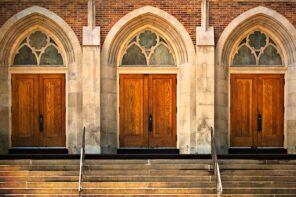When the archdiocese of New York announced in 2014 that it would begin closing parishes and merging them with neighboring churches, much of the media coverage was focused on the emotional impact. Generations of New Yorkers had worshipped in some of these parishes, and knowing that community ties would soon fray and sever was a painful experience. Cardinal Dolan argued that the decision was “about the future” and “about strength and renewal,” but parishioners felt angry and betrayed. The archdiocese, after all, is the largest landowner in New York: what would be done with these properties? Answers were not forthcoming.
When news trickled out that the archdiocese had spent $175 million dollars to restore St. Patrick’s Cathedral in advance of Pope Francis’ visit to New York, anger tuned to bitterness. And with Cardinal Dolan’s history of having shifted diocesan funds around during the sex abuse scandals when he was Archbishop of Milwaukee, many were skeptical about the reason for these parish closures, and frustrated by the lack of transparency. The numbers of Catholics who attend weekly Mass may be shrinking, but some of those parishes were financially solvent. Dolan, according to canon lawyer Sister Kate Kuenstler, exacerbated the secrecy and “created chaos in the process, and confusion.”
But the closures and mergers finally arrived. And when they did, a group of Catholics and people involved in housing rights began to wonder if, rather than being razed and converted to condos, as most closed churches have been in densely populated urban areas, these churches might serve another purpose. As of 2015, there are approximately 60,000 homeless people in New York, including close to 25,000 homeless children. As with most other cities, available shelter to meet these needs is inadequate.
Karen Gargamelli, who works as a foreclosure prevention attorney in New York, is one of the activists behind the Open These Doors campaign, which hopes to convince Dolan that the closed parishes should be repurposed into housing for poor and low-to-moderate income New Yorkers. She explains her work as a “raw daily encounter with the housing crisis.” In response to Dolan’s decision to shutter some parishes that could not fight to stay open, Gargamelli responds that “we’re saying as Catholics that they should be converted to permanent affordable housing, or if they don’t have the resources for that, they should give or sell at an affordable rate.”
She explains her work as a “raw daily encounter with the housing crisis.” In response to Dolan’s decision to shutter some parishes that could not fight to stay open, Gargamelli responds that “we’re saying as Catholics that they should be converted to permanent affordable housing, or if they don’t have the resources for that, they should give or sell at an affordable rate.”
Jimmy Hannigan, another Catholic involved in the campaign, says that they were “grappling with the idea of vacant space, the church and homeless crisis. Advent was coming up, and we saw the link about specific churches that had been closed and wanted to sign a light on these specific buildings.”
The result is a website, Twitter, and Instagram that mimics a traditional Advent calendar, with an image of a closed church’s doors unveiled every day. “We wanted it to be a joyful action,” Hannigan says, adding that “church doors are pretty powerful visually,” and that the calendar might help people prepare “in a different way” for Christmas.
Hannigan and Gargamelli both say that as Catholics, they hope Dolan will move closer to Pope Francis’ message of care for the marginalized. “Especially in New York, where gentrification is rampant,” Hannigan says, “the church is in a unique position as such a big landowner.”
Gargamelli mentions a speech Pope Francis gave in 2013 in Lampedusa, Italy, where thousands of migrants have died making the crossing from Africa. In that speech, the Pope said that empty convents and monasteries “should not be turned into hotels by the Church to earn money … (the buildings) are not ours, they are for the flesh of Christ, which is what the refugees are.”
Gargamelli adds that the church, as a property owner, has a “social responsibility that comes with that. Buildings,” she says, “belong to the marginalized.”
Several years ago while staying in Los Angeles, I looked out the window and noticed that the loud, purple-lit nightclub across the street blasting beats late into the night was actually a former church – the former cathedral, in fact. In another part of LA, I saw a former church turned into a clothing boutique, and a closed church in Berkeley, where I work, has been converted into luxury lofts. Dolan himself resides in a 15,000-square-foot mansion on Madison Avenue valued at 30 million dollars, “which is reportedly filled with thick red carpets and priceless antiques.”
As Christians get ready to celebrate the birth of a savior who was born to poor parents in an occupied territory and later became a refugee, the daily unveiling of images of closed church doors sends a powerful message. Will these be sold to the highest bidder, razed and converted to housing and shopping opportunities for the rich, or will they be opened again? Because the person outside waiting to come in is the person who most resembles that Palestinian Jew born in a manger: hungry and vulnerable, cold and poor.





